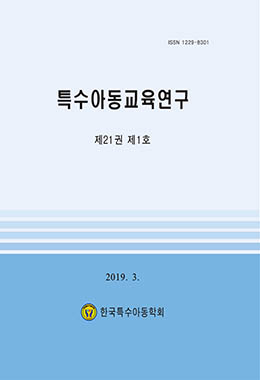연구목적: 본 연구의 목적은 AAC를 활용한 스토리텔링 중재가 지적장애 성인의 내러티브 기술에 미치는 효과를 밝히는 것이었다. 연구방법: 연구 참여자는 보호작업장에서 일하는 24세-30세의 지적장애 성인 3명이었다. 연구 설계는 대상자간 간헐중다기초선 설계에 의해 진행되었으며, 중재는 8가지 스토리텔링 중재 활동으로 이루어졌다. 중재 활동은 ‘이야기 듣고 다시 말하기’, ‘그림 삽화 순서대로 이야기하기’, ‘이야기 듣고 질문에 답하기’, ‘접속사 사용하여 말하기’, ‘핵심단어와 관련된 이야기 진행하기’, ‘육하원칙에 맞게 이야기하기’, ‘이어질 내용 상상하여 이야기 해보기’, ‘자신이 경험 또는 느낀점 이야기하기’ 활동으로 구성되었다. 연구결과: 첫째, AAC를 활용한 스토리텔링 중재는 지적장애 성인의 내러티브에서 주제연계성 기술의 향상에 효과적이었다. 둘째, AAC를 활용한 스토리텔링 중재는 지적장애 성인의 내러티브에서 명확성 기술의 향상에 효과적이었다. 셋째, AAC를 활용한 스토리텔링 중재는 지적장애 성인의 내러티브에서 지시성 기술의 향상에 효과적이었다. 넷째, AAC를 활용한 스토리텔링 중재는 지적장애 성인의 내러티브에서 결속성 기술의 향상에 효과적이었다. 다섯째, AAC를 활용한 스토리텔링 중재는 지적장애 성인의 내러티브에서 유창성의 향상에 효과적이었다. 결론: 본 연구의 결과는 우리나라에서 지적장애 성인의 내러티브 중재에 대해 많은 정보를 제공할 것으로 사료된다.
Purpose: The purpose of this study was to investigate the effects of storytelling intervention using AAC on the narrative skills of adults with intellectual disabilities. Method: The participants of this study were three adults with intellectual disability (24 to 30 years old) working in sheltered workshop. The study used a multiple probe design across subjects and the intervention program consisted in eight storytelling activities including ‘listening and retelling a story, ‘telling the story based on a sequence of illustrations’, ‘answering questions about the story’, ‘telling using conjunctions’, ‘telling a narrative based on a topic, ‘telling based on six Wh’ questions, ‘telling the story imagining the contents’, and ‘telling own experiences and feelings.’ Results: Results indicated that the storytelling intervention program was effective to improve topic maintenance, explicitness, referencing, conjunctive cohesion, and fluency of participants. Conclusion: The results of this study will provide useful information about narrative intervention using AAC for adults with intellectual disabilities.


